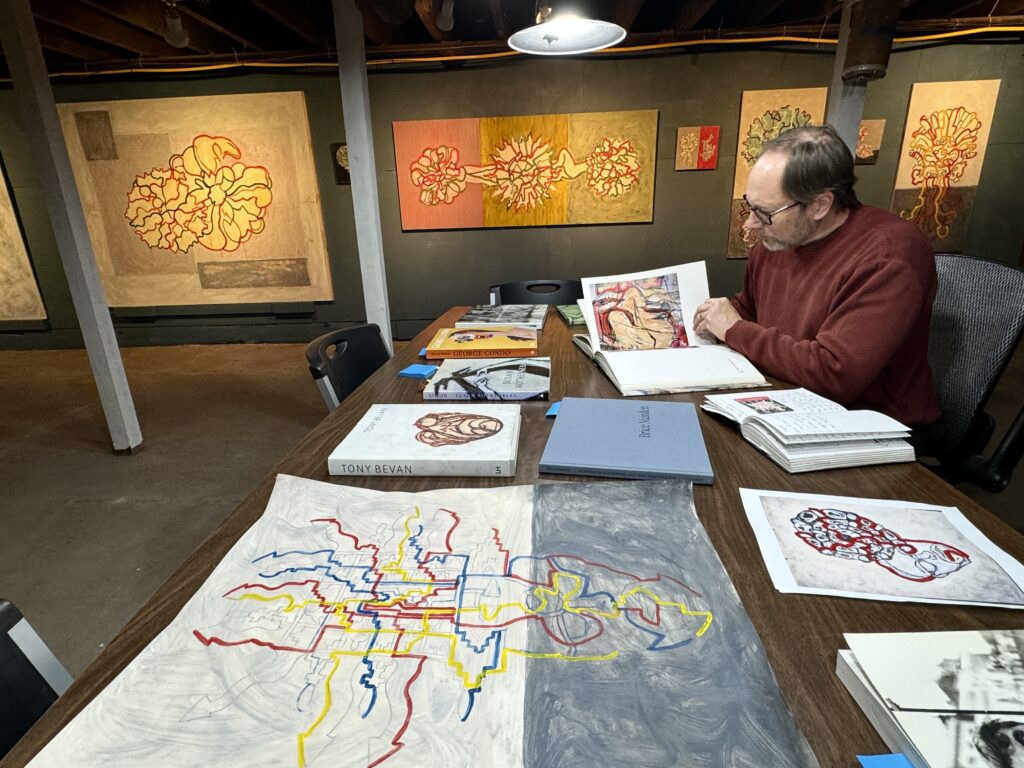Suggested Media from Dan

We moved quite a few times when I was a child, and in this regard my mother would always say: “With you father we always have to move twice; Once with all of our stuff, and a second time with all your father’s books.” I inherited my father’s affinity for books and all informational media, and Snowdrift has given me the space to amass a library of over 5000 books and hundreds of CDs and DVDs. I tend to see my library as an extension of my mind, and my books, periodicals, journals, CDs and DVDs, with all the notes, page markers and references I have applied to them over the years offer an endless personalized source of inspiration for making new work. Just as the layers of artwork and materials in Snowdrift inspire me to keep working, the photographs, idea tables of books and journals, monitors with museum slide shows and videos and various music amplifier systems (Snowdrift has 5 high fidelity music systems located in various parts of the building and six Alexa locations that can play music and podcasts on demand) add another layer of inspiration and information that allows my work to evolve in endless permutations.
The process of designing the LSA exhibit made me take a closer work on the impact of media on my process, and this very short list of media is a record of the items that found their way to the exhibit idea table for the Arrays exhibit.
Suggested Media
“The Shape of Time”, George Kubler, Yale University Press; Revised edition (April 17, 2008)
A book on anthropology that influenced many artists. It presents a theory of how objects shape our concept of history and of how artists create influences and follow paths of creation that mimic a space time concept of art and history.
“Artempo, Where Time Becomes Art” – MER/Paper Kunsthalle (August 1, 2008)
This book documents Axel Vervoordt’s exhibition of an eclectic mix of objects, ranging from ancient to contemporary at the Palazzo Fortuny in Venice. Vervoordt does not seem to care about when objects were made, or their value. He seems driven by how objects interact with each other and how they exist in Palazzo Fortuny, which has a wonderfully worn and aged feel. He is a master of array manipulation. It is a very Dominique de Menil way of looking at art.
“Lee Bontecou” – Koenig Books,
A favorite artist of mine that utilizes a conglomerate of materials to make sculptures that resemble biomorphic forms and galaxies. The final chapter of this book includes the construction of an artist’s sandbox that has a selection of her sculptures thoughtfully placed in it. The process of placing these sculptures is fascinating to me. Things that might not garner notice suddenly rise to prominence in the little worlds she creates
“Byzantine Things In The World” – The Menil Collection; Illustrated edition (June 18, 2013)
A catalog from the Menil Collection exhibit that connects the notion of “things thinging” in the Byzantine world to how art objects function in a gallery, museum or studio. It questions the blinders we have introduced to the perception of “art” in these spaces.
“Donald Judd Spaces”
The Menil Collection and Houston and Donald Judd’s art spaces in Marfa and New York represent the closest model of a “neighborhood museum” that I have always wished for Winslow. Judd’s appreciation for the historic character of a building, his almost religious respect for his materials, and his way of living in his work space all strike similar notes to Snowdrift. As I have read through art books, I have noticed that Judd, Byzantine perspective and The Menil Collection are related and discussed in terms of one another. Add to this Michael Kimmelman’s book, “The Accidental Masterpiece”, and the chapter on pilgrimage to Southwestern art places, and you have this odd “religion” of Southwestern art that is attractive to even an atheist like myself.
The Films of Charles and Ray Eames – “901: After 45 Years of Working, Volume 1
Many things are at work in this documentary. There is the evolution of a space over a period of decades. There is the concept of the space as not being settled, moveable walls, things in progress, remains of older projects combined with the new, inspiration coming from surrounding yourself with material, of the space defining the artist evolving identity. Beyond that there is the reality of the space ending, the artists dying, and what happens after that.
Over Your Cities Grass Will Grow
There is a second film on Anselm Keifer called “Anselm” that has much the same feel. I like Over Your Cities Grass Will Grow better for a number of reasons: 1) Minimal explanation about the artist and space, moments of great silence. 2) Kiefer is a “world builder”, and I understand the nature of how he creates space. 3) Some moments where the camera goes from the studio/outer space to the office,library/inner space. It is similar to moving through the space in Snowdrift and to the way we live in the space through the seasons. 4) The focus on materials and found objects in the creation of the space. 5) The respect for decay and history in the space. The emphasis on the character of the materials, the respect for the process of working the materials.
Art 21
Hellboy’s World
